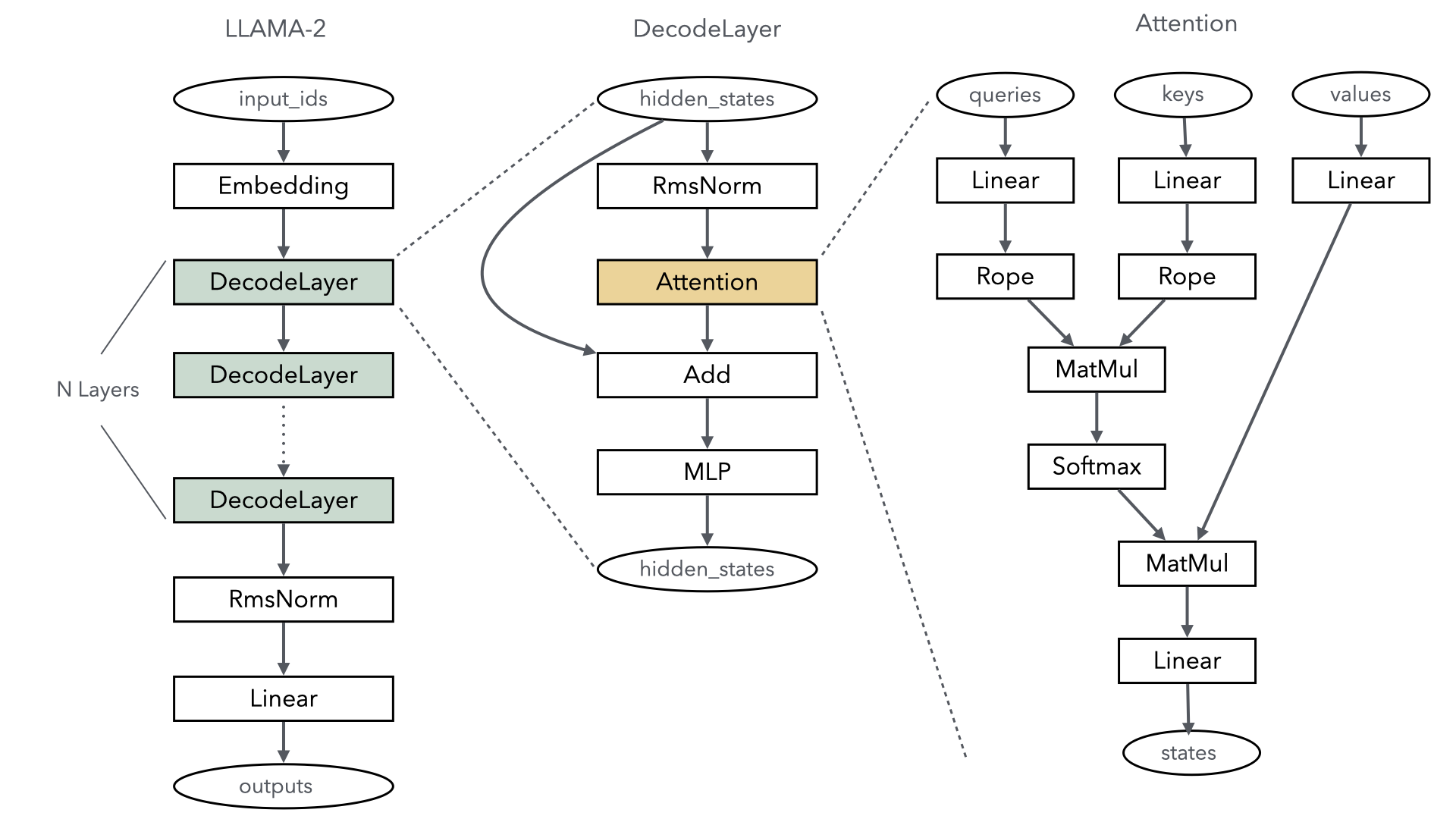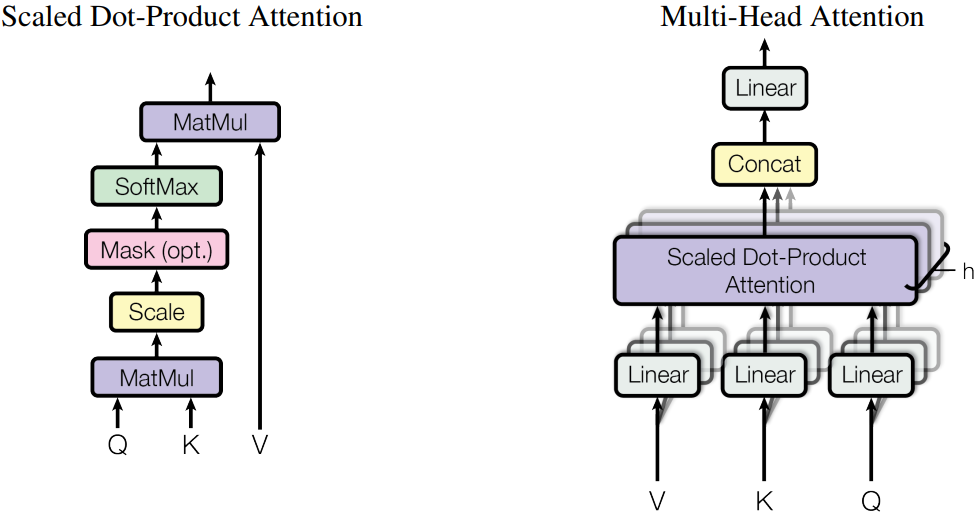从零构建大语言模型推理网络
大语言模型主干网络
当前主流的大语言模型主干网络都以基于transformer结构为主的,其中最为重要的就是Self-Attention机制的计算,以Llama2大语言模型为例,下图简单描述了其主干网络结构:

由此可见,Llama2的核心层主要分为以下几部分:
Embedding:将每个token对应的索引转换成一个向量,实现特征分散效果,类似onehot向量化,embedding的权重会参与训练过程,可以更好的适配语言模型中上下文语义,其实现就是一个Embedding算子既可完成。
DecodeLayer:即Transformer结构,是大语言模型关键计算,通常根据配置不同,会重复多层计算,每一层实际就是一个Transformer结构,是大语言模型核心之一。
RmsNorm&Linear:输出线性归一层,在Transformer结构计算完后,将结果归一成和模型词表一样的维度,最终输出成每个token的概率分布返回。
使用Mindspore大语言模型推理构建网络,可以根据MindSpore提供的算子自己拼装,下面以一个典型的Transformer模型为例,简单描述如何构建模型过程。
TransformerModel
在典型的Transformer大语言模型中,每一层layer都由Normalization、Attention、残差连接、MLP(MuliLayer Perception)组成。其中Attention和MLP都符合两个连续矩阵乘的要求。
Attention
当前主流Attention都采用了MHA(Muli-Head Attention)多头注意力结构,下图是MHA的具体形式,我们可以根据这个结构来构建Attention的网络。

Attention模块编码示例如下:
class Attention(nn.Cell): def __init__(self, config): super().__init__() self.num_heads_per_partition = config.num_heads self.head_dim = config.hidden_size // config.num_heads self.norm_factor = math.sqrt(self.head_dim) self.q = nn.Linear(in_channels=config.hidden_size, out_channels=config.hidden_size, weight_init='normal', has_bias=config.has_bias) self.k = nn.Linear(in_channels=config.hidden_size, out_channels=config.hidden_size, weight_init='normal', dtype=config.dtype, has_bias=config.has_bias) self.v = nn.Linear(in_channels=config.hidden_size, out_channels=config.hidden_size, weight_init='normal', dtype=config.dtype, has_bias=config.has_bias) self.flash_attention = ops.operations.nn_ops.FlashAttentionScore(head_num=self.num_heads_per_partition, scale_value=1.0/self.norm_factor, next_tokens=0) self.out = nn.Linear(in_channels=config.hidden_size, out_channels=config.hidden_size, weight_init='normal', dtype=config.dtype, has_bias=config.has_bias) def construct(self, x, mask): query = self.q(x) key = self.k(x) value = self.v(x) _, _, _, context_layer = self.flash_attention(query, key, value, attn_mask=mask) output = self.out(context_layer) return output
可以通过下面的代码来执行Attention计算:
mask = np.ones(shape=(config.seq_length, config.seq_length), dtype=np.uint8) mask = np.triu(mask, 1) mask = Tensor(mask) attention = Attention(config=config) attention_output = attention(embedding_output, mask) print(attention_output.shape)
MLP
MLP模块由2个连续的全连接层构成,示例代码如下:
class MLP(nn.Cell): def __init__(self, config): super().__init__() self.w1 = nn.Linear(in_channels=config.hidden_size, out_channels=config.ffn_hidden_size, weight_init='normal', dtype=config.dtype, has_bias=config.has_bias) self.w2 = nn.Linear(in_channels=config.ffn_hidden_size, out_channels=config.hidden_size, weight_init='normal', dtype=config.dtype, has_bias=config.has_bias) self.act_func = nn.SiLU() self.mul = ops.Mul() def construct(self, x): x = self.w1(x) x = self.act_func(x) output = self.w2(x) return output
可以通过下面的代码来执行Attention计算:
mlp = ParallelMLP(config=config) mlp_output = mlp(attention_output) print(mlp_output.shape)
TransformerLayer
通过的Attention模块和MLP模块,可以构建TransformerLayer,即DecodeLayer,具体如下:
class TransformerLayer(nn.Cell): def __init__(self, config): super().__init__() self.attention = Attention(config=config) self.feed_forward = MLP(config=config) self.attention_norm = RMSNorm(dim=config.hidden_size, dtype=config.dtype) self.ffn_norm = RMSNorm(dim=config.hidden_size, dtype=config.dtype) self.add = ops.Add() def construct(self, x, mask): norm_output = self.attention_norm(x) attention_output = self.attention(norm_output, mask) norm_input = self.add(x, attention_output) norm_output = self.ffn_norm(norm_input) mlp_output = self.feed_forward(norm_output) output = self.add(norm_input, mlp_output) return output
可以通过下面的代码来执行TransformerLayer计算:
transformerlayer = TransformerLayer(config=config) transformerlayer_output = transformerlayer(embedding_output, mask) print(transformerlayer_output.shape)
TransformerModel
通过堆叠TransformLayer,构建TransformerModel.
class TransformerModel(nn.Cell): def __init__(self, config): super().__init__() self.embedding = VocabEmbedding(num_embeddings=config.vocab_size, embedding_dim=config.hidden_size, init_method='normal', init_type=config.dtype) self.layers = nn.CellList() self.num_layers = config.num_layers for _ in range(config.num_layers): layer = TransformerLayer(config=config) self.layers.append(layer) self.norm_out = RMSNorm(dim=config.hidden_size, dtype=config.dtype) def construct(self, x, mask): hidden_state = self.embedding(x) for i in range(self.num_layers): hidden_state = self.layers[i](hidden_state, mask) hidden_state = self.norm_out(hidden_state) return hidden_state
可以通过下面的代码来执行TransformerModel计算:
transformer = TransformerModel(config=config) transformer_output = transformer(input_ids, mask) print(transformer_output.shape)
具体端到端的大语言模型代码工程可以参考model_dev.py脚本(设置CommunicationHelper的size为1),运行下面命令进行验证:
msrun --worker_num 1 --local_worker_num 1 --master_port 8124 --log_dir msrun_log --join True --cluster_time_out 300 model_dev.py